Introduction to SysML v2
SysML v2 is an evolution of the original Systems Modeling Language (SysML v1). It introduces impactful improvements that aim to address the limitations of its predecessor. First of all is the way systems are modeled, since it enhances the precision, consistency, expressiveness, and interoperability of this process.
SysML v2 was also developed with the goal to better support Model-Based Systems Engineering (MBSE) by improving the language’s usability, extensibility, and its adoption. In contrast to SysML v1, which was built as an extension of UML (Unified Modeling Language), SysML v2 features a new metamodel that is not constrained by UML, and is instead focusing specifically on systems modeling.
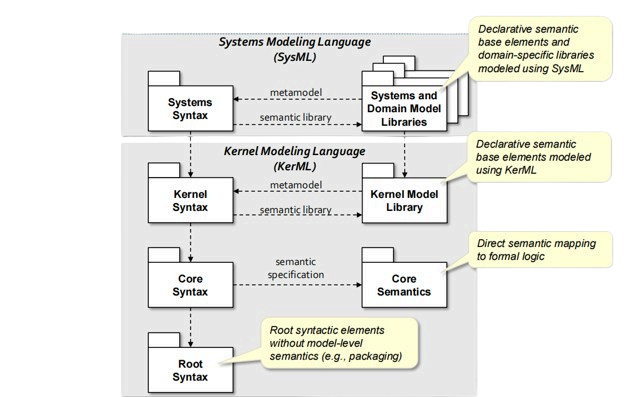
1.) SysML v2 Language Architecture
Key Features and Capabilities of SysML2
1. A new Metamodel:
The SysML v2 metamodel provides a sturdy foundation that supports systems modeling while still preserving most of UML's capabilities. In addition, it offers more flexibility and puts more focus on formal semantics to create precise models. KerML (Kernel Modeling Language) is the core of this metamodel, providing a direct mapping to formal logic.
2. Graphical, Tabular, and Textual Notations:
SysML v2 supports a variety of notations to visualize systems. Graphical representations are complemented by textual syntax to offer modelers more flexibility. The graphical syntax is based on a structured graphical Backus-Naur Form specification, which ensures consistency between different notations.
3. API & Services:
A key innovation in SysML v2 is the standardized API. This allows tools and applications to access SysML models and supports services such as creating, updating, deleting elements, querying the model, and navigating through it. The result is a greatly enhanced interoperability with other tools, promoting smooth integration into existing engineering workflows.
4. Enhanced Usability & Extensibility:
One of the main goals that SysML v2 was developed with, was usability. As such, it’s catering to both model developers and consumers. It aims to make modeling more intuitive while not compromising on the precision required for complex systems. In addition, the language is designed to be extensible, allowing users to adapt it to domain-specific applications.
5. Support for Multiple Engineering Domains:
SysML v2 caters to a variety of domains that include hardware, software, personnel, and processes. The system’s versatility is what enables it to comprehensively model complex systems by supporting detailed specification, analysis, design, verification, and validation across all of these domains.
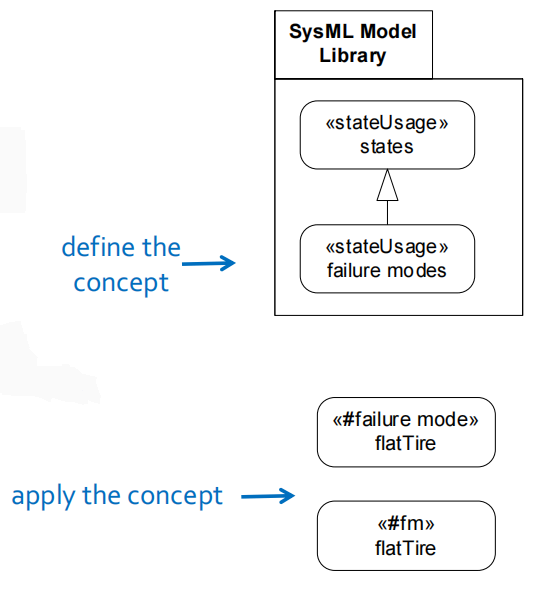
2.) SysML2 capability to adapt to domain-specific needs
6. Formal Semantics and Regularity:
The formal semantics in SysML v2 are grounded in logic and provide the capability to build models that can be consistently interpreted across various contexts. This also brings consistency in its usage and terminology, the result of which is the streamlining of the modeling process and a reduction in ambiguity.
7. System Decomposition and Usage Patterns:
SysML v2 simplifies the decomposition of systems into parts, actions, and states, enabling clear and consistent modeling of system structures and behaviors. The language provides a definition and usage pattern, which ensures elements are consistently used in different contexts.
8. Variant Modeling and Configuration:
It introduces variability mechanisms, which allow modelers to represent different design alternatives within the same model. Variation points and variants are both supported and they can be constrained based on specific system configurations. This proves especially useful when designing systems with multiple versions or options.
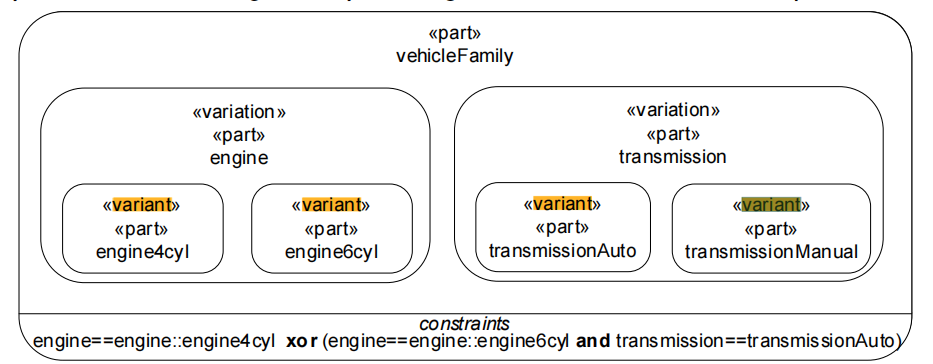
3.) Variant modeling example
9. Trade-Off and Analysis Cases:
With the inclusion of analysis cases and trade-off studies, SysML v2 enhances support for system optimization. Users are able to model different alternatives, define evaluation functions, and perform trade-off analyses to select the optimal design based on specific criteria, like for example performance, cost, or efficiency.
10.Behavior Modeling:
SysML v2 offers upgraded tools for behavior modeling and supporting function-based, state-based, and sequence-based behaviors. This feature allows modelers to define how systems will act under certain conditions, how they respond to events, and how their different parts interact dynamically
11. Snapshot and Time Slice Modeling:
One of the more advanced features is its support for modeling systems in terms of snapshots and time slices. Making temporal decomposition of models possible, it represents how a system's configuration may evolve over time, for example, tracking the condition of an individual part at different points in its lifecycle.
12.Requirement Management and Verification:
SysML v2 integrates requirements management directly into the modeling process. This allows users to define and verify requirements through a tree of nested requirement elements. It also supports verification cases that evaluate whether the system satisfies these requirements, which results in an enhancement to traceability and also compliance with design specifications.
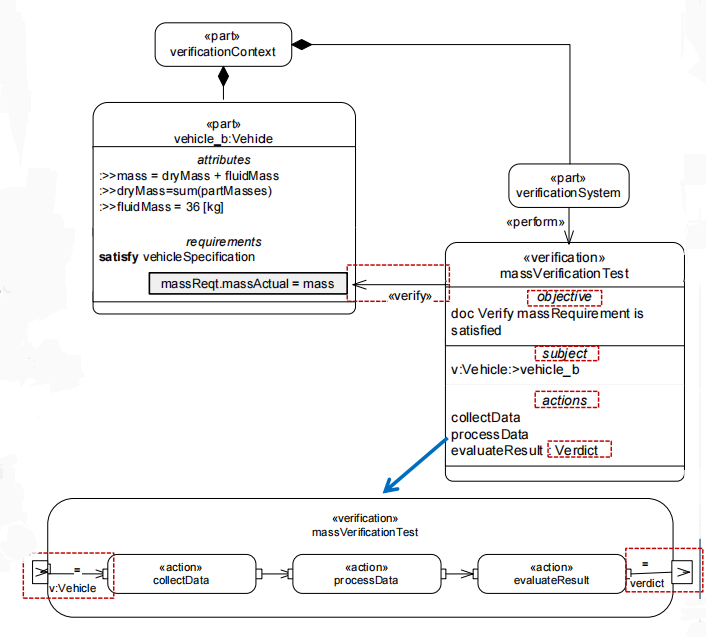
4.) Example of requirement verification in SysML v2
Key Differences between SysML v1 and v2
SysML v2 represents a significant step forward over SysML v1 in several areas:
● Simplicity and Consistency: SysML v2 provides a more intuitive system with consistent definitions and usage patterns. Many of the complexities and inconsistencies found in SysML v1 are removed from its successor.
● Formal Semantics: The formal semantics embedded in SysML v2 ensure models are more precise and less prone to misinterpretation.
● Enhanced Extensibility: SysML v2’s design allows for easier extension and customization to fit specific domains, which results in making it more adaptable to different engineering applications.
● Interoperability: SysML v2 includes a standardized API, which was missing in SysML v1. This facilitates better integration with other tools and supports more automated and efficient workflows.
● Variant Modeling and Trade-Off Analysis: SysML v2 introduces more advanced support for variant modeling and trade-off analysis and offers tools to evaluate and optimize design choices.
The New Generation of MBSE Tools - IBM Rhapsody SE:
The purpose of IBM Rhapsody SE, the company's newest tool, is to simplify and improve systems engineering. With SysML v2 at its core, it enables engineers to effectively tackle complicated designs and model, examine, and optimize systems with ease.
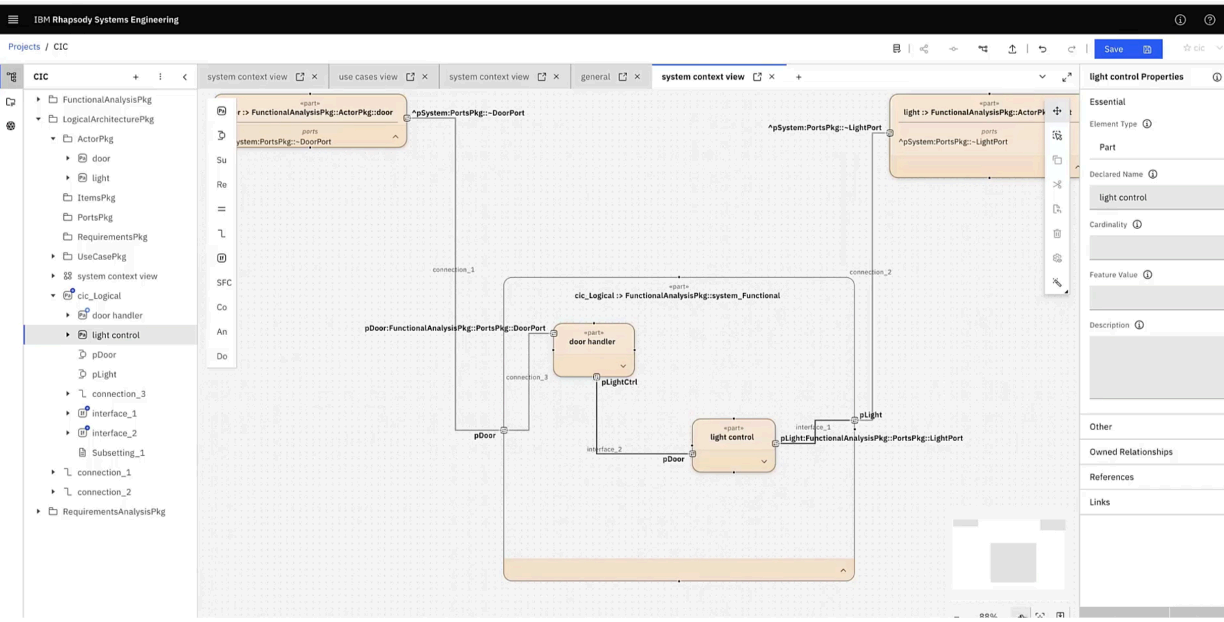
5.) IBM Rhapsody SE UI
Highlights of IBM Rhapsody SE:
1. Designed with the cloud in mind: Because Rhapsody SE is cloud-ready, teams can work together from any location. The newest web technologies, such as RESTful APIs and GraphQL, give it flexibility and scalability. Team members can collaborate well no matter where they are.
2. Smooth Inter-Team Cooperation: Rhapsody SE facilitates data sharing across several engineering teams by utilizing the JSON format and SysML v2's APIs. It seamlessly interfaces with DOORS Next Generation and other tools, allowing engineers to maintain departmental synchronization of requirements and models.
3. Simple to Use: The UI of Rhapsody SE is modern and easy to use. Experienced engineers can immediately catch up, while new users find it easy to understand. You can work in the format that best suits the task by switching between text-based and graphical modeling.
4. HarmonyMBE-Powered Automated Workflow: Rhapsody SE integrates with IBM's HarmonyMBE system, which automates a number of model-based engineering processes. Early design validation, flexible work, and seamless collaboration are all made easier by automating the production of models and views across architectural layers.
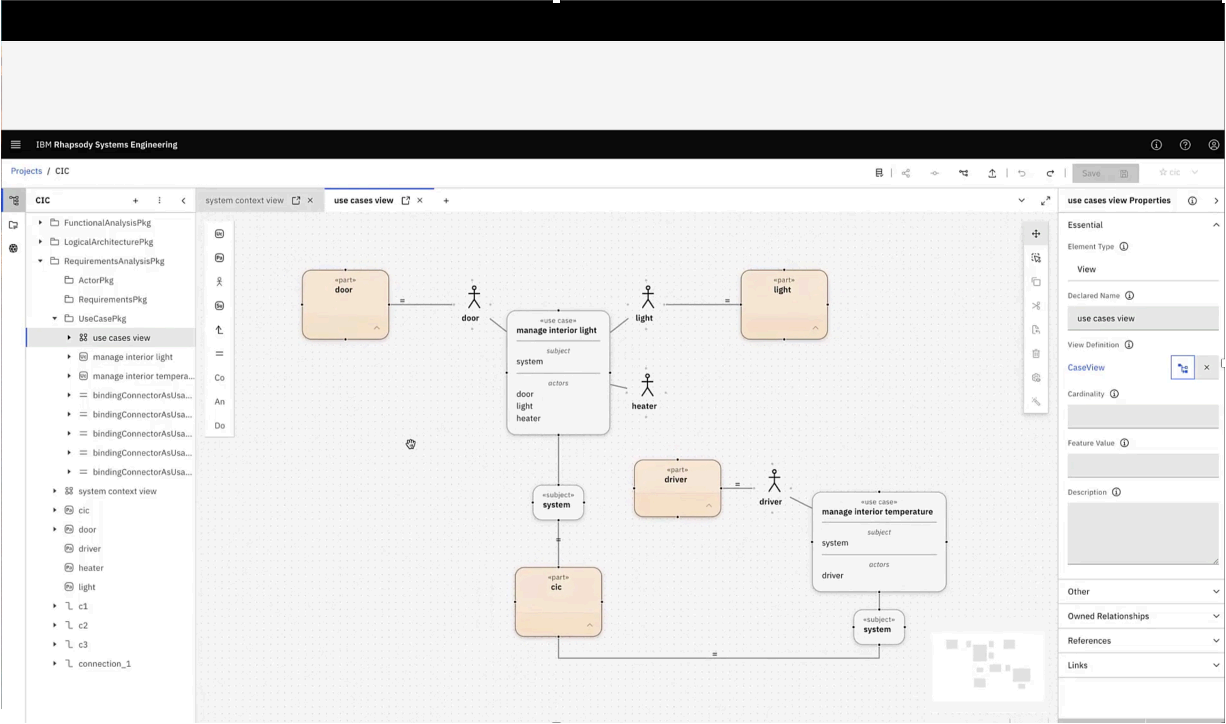
06.) Use Cases Map Structure Showcase
Why IBM Rhapsody SE with SysML v2 is a Game-Changer
1. Early Validation and Automated Design: Rhapsody SE enables engineers to generate and verify important views, such as white-box and black-box diagrams, at an early stage in the design process. The automation that HarmonyMBE has built in streamlines development and guarantees that designs are accurate from the outset.
2. Simple and Straightforward Cooperation: Engineers from a variety of disciplines, including mechanical, electrical, software, and systems, may easily collaborate on the same model using the cloud-based platform and SysML v2's standardized APIs, keeping everything in line.
3. Simple to Use: Rhapsody SE's web-based approach minimizes the requirement for IT setup and makes it accessible, even for smaller teams. This facilitates quick implementation of the product by teams of any size.
4. Scalability and Customization: Rhapsody SE is designed to expand to meet the demands of your project. As systems get more complicated, it can be expanded by teams using domain-specific languages (DSLs) and unique integrations.
In short, IBM Rhapsody SE combines powerful automation, cross-team collaboration, and user-friendliness to support engineers at every stage of the design process, making MBSE faster and easier than ever before.
Conclusion
Model-Based Systems Engineering (MBSE) is redefined by IBM Rhapsody SE, which is driven by SysML v2 and offers enhanced automation, flexibility, and precision. SysML v2 is perfect for complex systems engineering because of its extensive toolkit, which includes variant modeling, trade-off analysis, and behavior modeling. Early validation is made possible by Rhapsody SE's connection with HarmonyMBE, and its cloud-based architecture guarantees smooth teamwork even when teams are far apart. SysML v2 and Rhapsody SE work together to provide a robust, cutting-edge MBSE solution that helps engineers at every step of the design process.2. Simple and Straightforward Cooperation: Engineers from a variety of disciplines, including mechanical, electrical, software, and systems, may easily collaborate on the same model using the cloud-based platform and SysML v2's standardized APIs, keeping everything in line.
3. Simple to Use: Rhapsody SE's web-based approach minimizes the requirement for IT setup and makes it accessible, even for smaller teams. This facilitates quick implementation of the product by teams of any size.
4. Scalability and Customization: Rhapsody SE is designed to expand to meet the demands of your project. As systems get more complicated, it can be expanded by teams using domain-specific languages (DSLs) and unique integrations.
In short, IBM Rhapsody SE combines powerful automation, cross-team collaboration, and user-friendliness to support engineers at every stage of the design process, making MBSE faster and easier than ever before.
Softacus Services
We, in Softacus, are experts when it comes to consulting and service delivery of IBM software products and solutions in your business. We help our clients to improve visibility and transparency when licensing and managing commercial software, providing measurable value while increasing efficiency and accountability and we are providing services in different areas (see Softacus Services).
IBM ELM extensions developed by Softacus are free of charge for the customers who ordered IBM ELM licenses via Softacus or for the customers who ordered any of our services. If you are interested in any of our IBM ELM extensions, you found a bug or you have any enhancement request, please let us know at info@softacus.com.




